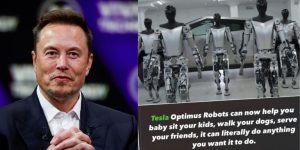
Tesla has once again redefined innovation, this time venturing into robotics with the unveiling of Optimus, their cutting-edge humanoid robot.
At the recent We, Robot event, CEO Elon Musk introduced Optimus as a revolutionary development, not just for Tesla but for industries and households globally.
Musk expressed his excitement, confidently claiming that Optimus could become “the biggest product ever”—surpassing even Tesla’s cars, solar solutions, and energy storage systems.
The Physical and Technical Build of Optimus
At first glance, Optimus looks like something straight out of a sci-fi movie. Standing at 5’8″ (173 cm) and weighing between 125-160 lbs (57-73 kg), the robot is engineered for smooth, human-like movement, thanks to 28 structural actuators that give it impressive dexterity. Its hands, with 11-22 degrees of freedom, allow Optimus to handle delicate objects and perform intricate tasks, from sorting packages to operating tools. This makes Tesla’s robot highly advantageous for industries such as manufacturing, logistics, and even personal household services.
Powered by Tesla’s neural network and AI systems, Optimus can adapt to its surroundings, learn new tasks, and operate autonomously. Equipped with eight autopilot cameras, similar to those in Tesla’s Full-Self Driving (FSD) vehicles, it can navigate spaces without human assistance. This allows Optimus to learn tasks by observing humans or through remote operation, making it a versatile and highly adaptable asset.
Capabilities and Use Cases: A Jack of All Trades
Tesla has ambitious plans for Optimus. During the unveiling, Musk showcased the robot’s ability to perform a variety of tasks, including carrying groceries, walking pets, babysitting, and even serving as a personal assistant. Picture a future where Optimus helps with morning chores, folds laundry, and serves coffee—all while adapting to your specific preferences.
In industrial settings, Optimus is poised to transform labor-intensive sectors. Musk highlighted its potential to replace humans in high-risk jobs, such as repetitive tasks in manufacturing, handling heavy materials, and navigating complex industrial environments. Tesla has already started testing Optimus in its factories, where it moves parts and assists on assembly lines.
This versatility positions Optimus to play a crucial role in industries beyond Tesla’s electric vehicle production. In logistics, the robot could streamline warehouse operations, minimizing human error and boosting efficiency. In service industries, it could perform roles ranging from bartending to hotel management—tasks that require physical interaction without the need for human judgment.
Watch the video below (swipe to view more to see how the Tesla’s Optimus Robots work)
Affordability: Bringing Robotics to the Masses
One of the most exciting features of Tesla’s Optimus is its anticipated price. Although the final version is still in development, Musk predicts that once Optimus goes into mass production, it will be priced between $20,000 and $30,000. This makes it significantly more affordable than many current humanoid robots, which often exceed $100,000. If Tesla meets these price targets, Optimus could become a reality for middle-class families within the next decade.
This affordability extends beyond homes. With costs projected to be much lower than human labor in various industries, businesses might find it economically viable to deploy fleets of Optimus robots in factories, logistics centers, and even retail settings. The long-term vision is to scale Optimus so that it becomes a common tool, much like smartphones and personal computers.
Watch videos and see reactions below;
WHAT’S THE HARDEST THING ABOUT BEING A ROBOT?
Optimus:
“Trying to be as human as you guys…”
Source: @teslaownersSV, @Tesla, @xai
— Mario Nawfal (@MarioNawfal) October 11, 2024
Tesla will also be making a catgirl version of the Optimus robot.
— DogeDesigner (@cb_doge) October 11, 2024
— Elon Musk (@elonmusk) October 11, 2024